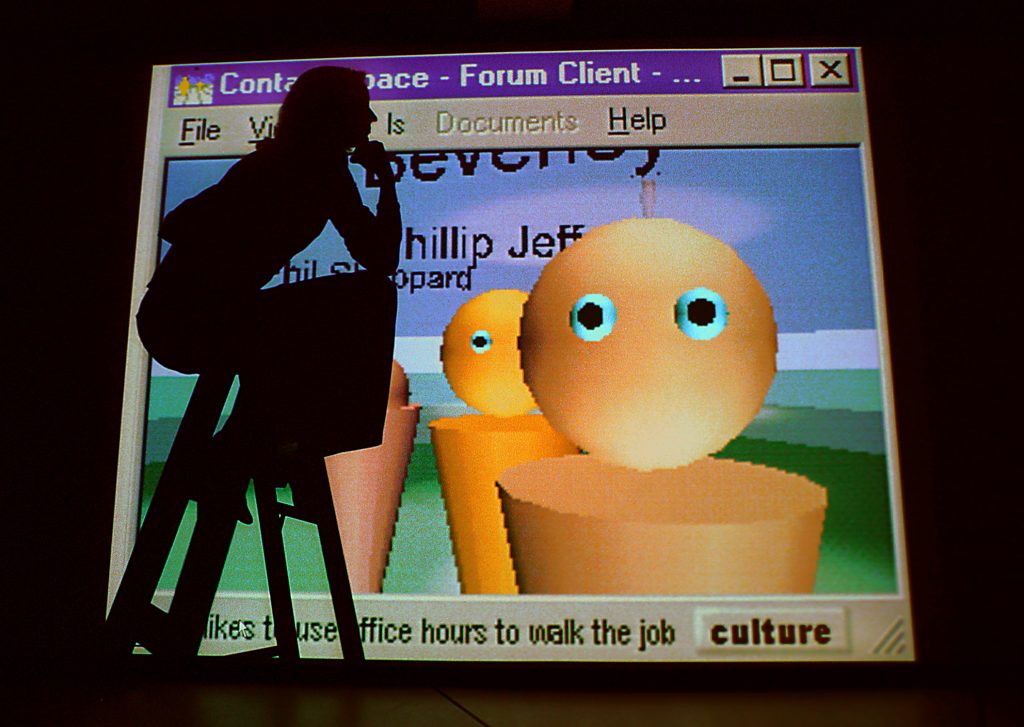
Download 300dpi JPEG image, ‘elaine.jpg’, 1.2Mb (Media are welcome to download/publish this image with related news stories.)
ALBUQUERQUE, N.M. — Elaine Raybourn, a member of the Advanced Concepts Group (ACG) think tank at the Department of Energy’s Sandia National Laboratories, is exploring new on-line communication methods that will allow her “to be in two places at once.”
She is communicating using collaborative virtual environments via the Internet that in many ways are every bit as robust and real as face-to-face interactions.
“When I was a little girl I always wanted to be in two places at once,” she says. “My parents always said ‘no you can’t.’ Well, now I’m proving them wrong with new online communication technologies.”
Raybourn’s expertise is making new online communication technologies as real-life as possible by adding culture and a sense of place. In particular, her focus is on what are termed object-oriented multi-user dimensions (MOOs) where people get together over the Internet to talk to each other, give presentations, conduct meetings, and manipulate data in real time in a sophisticated version of an online chat room.
Her interest in new ways of communicating led Gerry Yonas, Sandia vice president in charge of the Advanced Concepts Group, to invite her to join the year-old think tank in investigating potential contributions the national laboratory might make to solve long-range future problems of the nation.
“Her ideas fit in perfectly with my desire to create new tools for distance collaboration in solving global problems that depend not just on technology, but increasingly on culture and human behavior,” Yonas says.
Raybourn creates an atmosphere of reality in a virtual space by inserting organizational culture and intercultural communication cues into the situation. The cues, she says, can be as simple as a mouse click on an avatar — a graphical representation of a human being in a computer-generated world — in the virtual environment and learning that the person is available for Internet chatting every day from 3 to 5 p.m.
In designing communication software, Raybourn considers it important to make sure equity is part of the mix. Equity means ensuring that all members of collaborative virtual communities have a fair opportunity to contribute to the communication, and eventually the online community as it forms. For example, today most text-based environments give an advantage to people who type rapidly and communicate in short, consecutive sentences. They often have more “talk” time, or screen real estate — similar to the person who dominates the conversation in face-to-face interactions.
“Although we may strive to create equitable virtual environments, differing cultures make for complex and largely misunderstood social interactions,” says Raybourn. “Designers of collaborative virtual communities now have the opportunity and responsibility to consider the impact of the underlying dynamics of culture and intercultural interactions such as identity, negotiation, conflict, power, equity, and trust on virtual spaces and collaborative communities.”
Raybourn’s intent is to ensure that people like her — those with knowledge of design, intercultural communication, and the human factor — be included on software development and modeling and simulation teams.
Armed with her computer and intercultural knowledge, she is currently doing exactly that for British Telecom (BT), Britain’s version of AT&T. She is helping the company transform a virtual environment, called “Forum,” into a new communication medium that feels similar to a real face-to-face conversation. She was recently invited by BT to spend two weeks working at BT’s Advanced Communications Technology Centre, in Ipswich, England.
Although still in its infant stages and not yet commercially available, Forum already has several components that make it unique. One is the incorporation of avatars, which can be generic-shaped human figures representing people participating in the virtual conversation or a “photo-realistic three dimensional model” of an individual’s proportions, skin texture, eyes, hair style and clothes faithfully reproduced.
“The avatar is you in cyberspace,” Raybourn says. “When you enter a graphical environment, like Forum, or a text-based virtual world such as a MOO, your avatar might ‘walk’ on the computer screen and ‘sit down’ at a table with others in virtual meeting space. It’s your persona on the Internet.”
Forum will soon incorporate narrative information just a mouse click away that gives personal insights about who is talking at the other end of the Internet fiber optics line — based on suggestions made by Raybourn.
She believes conferencing and communicating via the Internet will become more prevalent in coming years and sees her efforts in designing cultural cues in collaborative virtual environments as a way to make the experience more meaningful.
“Designing culture into the communications software is one step toward fostering more meaningful Internet communication and laying the groundwork for the development of more equitable online communities,” she says. “It becomes the way to be in at least two places at once.”